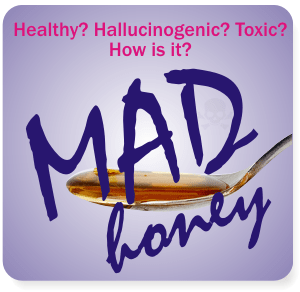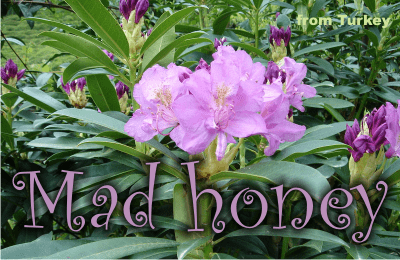You might have heard that rhododendron is a toxic plant. This is partially true because not all rhododendrons contain toxic compounds. Honey bees are attracted to all of them, toxic or non-toxic, and produce a tasty honey that, in spring, beekeepers usually leave in the hive for them, to feed themselves after a long winter.
The term rhododendron comes from the Ancient Greek and means Rose Tree. There are 1,024 species of woody plants in the Ericaceae family, either evergreen or deciduous.
They are mainly found in Asia, although they are also widespread throughout the highlands of the Appalachian Mountains of North America, Europe, and almost everywhere. Some places even “enjoy” some invasive species – as is the case with Rhododendron ponticum in Ireland and the United Kingdom. This species is difficult to eradicate, as its roots can make new shoots.
Rhododendron arboreum (lali guransh) is the national flower of Nepal. Other species are the state tree of several states of the Indian Union.
Rhododendron maximum, the most widespread rhododendron of the Appalachian Mountains, is the state flower of West Virginia, and is in the Flag of West Virginia.
Rhododendron macrophyllum, a widespread rhododendron of the Pacific Northwest, is the state flower of Washington.

Rhododendrons can be shrubs, small or large trees, the smallest species growing to 10–100 cm (4–40 in) tall, and the largest, R. protistum var. giganteum, reported to 30 m (100 ft) tall.
All species and hybrid rhododendrons (including azaleas) are extensively used as ornamental plants in landscaping in many parts of the world, including both temperate and sub-temperate regions. Many species and cultivars are grown commercially for the nursery trade.
Rhododendrons are often valued in landscaping for their structure, size, flowers, and the fact that many of them are evergreen. In some areas, larger rhododendrons can be pruned to encourage a more tree-like form, with some species such as Rhododendron arboreum and R. falconeri eventually growing to 10–15 m or more tall.
In the Indian state of Himachal Pradesh, rhododendron flowers have been used for some time to make popular fruit and flower wines. The industry is promoted by the state government with tax benefits, looking to promote this industry as a full-fledged subclass of its economy.
Honey bees love rhododendrons. How can they not? See how amazing their flowers can be….
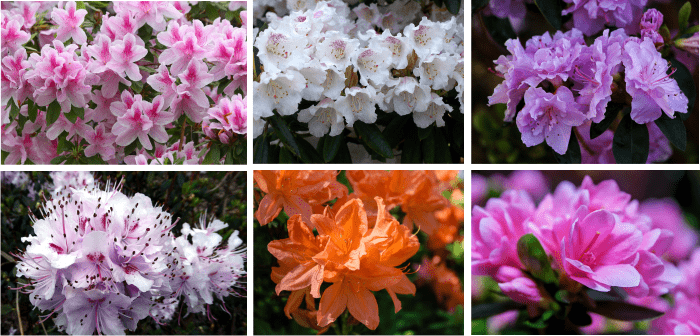
Traditional medicine has long used rhododendron for some conditions. Science has confirmed some of its benefits through animal studies and in vitro research, which confirmed possible anti-inflammatory and hepatoprotective activities, probably due to the antioxidant effects of flavonoids or other phenolic compounds and saponins the plant contains. (Agarwal, S.S et al., 1988)
Rhododendron symbolizes “danger” and “beware”!
Yes, names of flowers have different meanings. (source) As for our rhododendron, don’t you have the feeling of what it is like in our lives? That the most beautiful things (flowers here) are the most dangerous ones, too?
Rhododendron health uses:
Rhododendrons are so many and so different. In one species, leaves and nectar can be poisonous, while in other species, they can be rather healthy.
In 1991, William Watson wrote the book “Rhododendrons and Azaleas”, and quote Professor Sargent, who said “Rhododendron spp possess bitter, astringent, and narcotic properties“. But they are all different:
– In Siberia R. chrysanthum is used in the treatment of rheumatism and other affections of the joints and muscles
– In Europe, the same R. chrysanthum is used for the same purpose.
– in Northern Italy the buds of R. ferrugineum are used in the preparation of an anti-rheumatic liniment.
– in the United States a decoction of the leaves of R. maximum is occasionally used for the same anti-rheumatic liniment.
– in India the flowers of the Indian R. arboreum are eaten fresh or made into a conserve, although the buds and young leaves are said to be poisonous to cattle. Also in India the dried leaves of R. campaulatum are used as snuff, and the leaves of R. lepidotum and R. anthopogon as stimulants.
– In China leaves of various species are used to adulterate tea.
How is rhododendron honey, what are its characteristics?
Most rhododendron honey originates from the species and natural hybrids spread in the Alps and Pyrenees: R. ferrugineum L., R. hirsutum L. and their hybrid R. x intermedium. It’s a unifloral honey produced exclusively at an altitude where bees can stay only for a few months; therefore, the seasonal migration of hives is always required.
The harvest is not abundant (or even certain) because of the variable meteorological conditions and does not meet the demand. It is mostly sold in the production areas. Therefore, its market price is elevated.
Color: very light
Odor: weak woody and floral-fresh fruit
Sweetness: medium
Bitterness: absent
Acidity: weak
Crystallization rate: moderate
Specific pollen: 38.6 %. Rhododendron pollen is underrepresented (PG/10 g < 20 000), but relatively high percentages of the specific pollen are not rare.
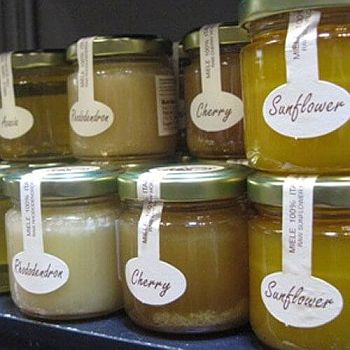
pH: 3.9
Electrical Conductivity: low, 0.23 mS/cm
Water content: 16.6 g/100 g
Diastase: 12.1 DN
Invertase: 79.6 U/kg
Proline: low, 264 mg/ kg
Fructose: 39.1 g/100 g
Glucose: 30.4 g/100 g
Sucrose: 0.6 g/100 g
Fructose / Glucose ratio: 1.29
Country of origin: Italy, France, and Austria.
Antibacterial potency: low to medium, of undetermined or non-peroxide type.
In 2009, KOC, A N et al. evaluated honey samples from different floral sources for their ability to inhibit the growth of 40 yeast strains (Candida albicans, C. krusei, C. glabrata and Trichosoporon spp.). It was shown that Rhododendron and multifloral honeys have generally more inhibitory effect than eucalyptus and orange honeys (P < 0.05). This classifies it in a an intermediate class of antibacterial activity of honey (like clover, lavender, linden, rape, rosemary, thyme, tupelo)
Just as a reminder, here are the honeys with high antibacterial activity: blueberry, buckwheat, chestnut, cotton, fire-weed, heather, jarrah, honeydew, linen vine, manuka, red gum, revamil, tualang, ulmo.
Where can we buy rhododendron honey from?
To make sure it’s clean rhododendron honey produced from species without toxins, make sure it is produced in Italy, France, or Austria. Of course, there are other countries producing it, including those from North America, but in those areas there are also toxic rhododendrons, and bees don’t make a difference.
Just go for the sure thing and buy honey made in the Alps or Pyrenees. You can find some on Amazon.com and Amaxon.co.uk.
From Pyrenees, you can find a polyfloral honey that includes rhododendron, which is tastier and healthier than the monofloral rhododendron honey. It is made from the nectar of: Lotus corniculatis (Birds foot trefoil), Thyme, Pear, Alpine clover, Backenklee, Oregano, Lavender, Wild Blackberry, Chestnut, Buckthorn, Rosemary, Rhododendron, Sainfoin, Hawthorn, Mountain Bluet, and Calluna (Ling Heather).
It is said that when bees feed themselves on plants at higher altitudes, the resulting honey would be of higher quality as the air is cleaner, the land unspoiled and the soils richer in nutrients for the plants that grow there.
Do not worry that the rhododendron honey that we find in our supermarkets or buy from trusted online shops is toxic. It is not. I have also said that in the article about mad honey, but I will say it again here:
1. Commercial honey packers receive honey from thousands of hives. If one hive is contaminated, after mixing all the honeys received, the toxin will be highly diluted.
2. To prolong the shelf life of “beautiful honey,” retard its crystallization, and kill yeast spores, honey is heated and processed. Since grayanotoxin (the toxin that exists in some rhododendron species) may be heat-labile, commercial processing of honey with heat may destroy grayanotoxin in honey. Yet, the amount of heat needed to destroy grayanotoxin is not known with certainty.
3. There are means of detecting and isolating grayanotoxin from rhododendron honey that are very well known by the producers that sell it.
4. Statistics show that only in Turkey (and Nepal), rhododendron honey turns to mad honey, though toxic Ericaceae are widely spread in North America, Europe and Asia. Yet, toxic Ericaceae may not be present with a high enough density outside of Turkey to produce toxic honey. The number of Rhododendron spp. growing on the hills and mountains of eastern Turkey is quite impressive. These Rhododendron species even threaten other commercial plant species.
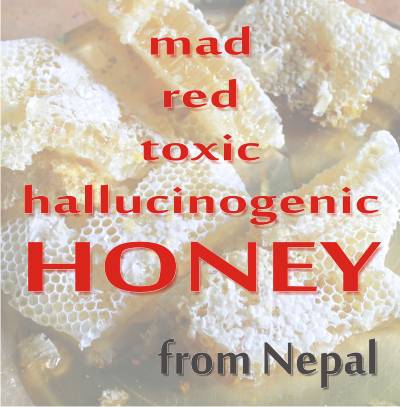
The rhododendron is the national flower of Nepal, where the flower is considered edible and enjoyed for its sour taste. The flower, fresh or dried, is added to fish curry in the belief that it will soften the bones. The juice of the rhododendron flower is used to make a squash called burans (named after the flower) in the hilly regions of Uttarakhand.
Health benefits of rhododendron honey
Just like any other honey. Externally to heal wounds and burns, for facial masks or as a valuable ingredient in beauty products like shampoos, soaps, hand creams etc. Internally, it is used mainly for the digestive system, starting from colds and sore throats to gastritis. It protects and detoxifies the liver; it helps with insomnia and cough.
Specific to rhododendron honey is that folk medicine recommends it for rheumatism.
And, of course, take one spoon of honey before and after a party with more alcohol. Thus, your liver will be quickly detoxified.
Read more: medicinal effects of mad honey from Turkey.
Recommended book: Rhododendrons of the World
This is an excellent book wrote in 1961 by David G. Leach describing each rhododendron. You’ll find here what species to plant in your garden – if you are a beekeeper, or if you simply want to avoid the danger of having them around your children. Their beauty can hide the most unpleasant effects.
Or try a more recent book, from 2015, Rhododendrons: An illustrated guide to varieties, cultivation and care, with step-by-step instructions and over 135 beautiful photographs.
==========
References and picture source:
“Language of Flowers – Flower Meanings and Flower Sentiments”.
KOC, A N; SILICI, S; ERCAL, B D; KASAP, F; HORMET-OZ, H T; MAVUS-BULDU, H (2009) Antifungal Activity of Turkish Honey against Candida spp. and Trichosporon spp: an in vitro evaluation. Medical Mycology 47 (7): 707-712.
Bee Product Science, www.bee-hexagon.net, April 2016
DE BODT, G (1996) Les miels de rhododendrons. Les Carnets du CARI Abeilles et Cie (50): 10-12.
Main European unifloral honeys: descriptive sheets1, by Livia PERSANO ODDO et al. 2004, Apidologie 35 (2004) S38–S81
Esen D, Yildiz O, Kulac S, Sarginci M. Controlling Rhododendron spp. in the Turkish Black Sea Region. Forestry 2006; 79:177–184.
Rhododendron flowers – pictures source Pixabay.com

